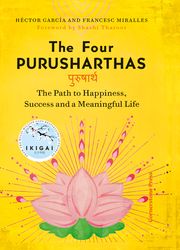There is something deeply common between Shashi Tharoor and the writer duo of Francesc Miralles and Hector Garcia. They draw from the same well of liberal religious philosophies. Perhaps it was this that drew them close when the authors of Ikigai―the international bestseller―headed to India in search of the secret to a happy life
In his foreword for their new book The Four Purusharthas: The Path to Happiness, Success, and a Meaningful Life, the author of Why I Am A Hindu questions what being a Hindu means. “My Hinduism is a lived faith; it is a Hinduism of experience and upbringing, a Hinduism of observation and conversation, not one anchored in deep religious study,” Tharoor writes.
Growing up, liberal instincts made Miralles and Garcia look beyond their cultures. “Visitors to India are surprised to encounter such cultural diversity in a single place: colourful Hindu temples, churches in Goa and Kerala, sublime mosques like the one in New Delhi and the Islamic mausoleum of the Taj Mahal,” they write in their book. “One gets the impression that the entire world, at least as far as spirituality goes, is here.”
Garcia’s Catholic parents did not stop him from exploring new ideas. “I started reading science books and developed a scientific temperament, but was also interested in learning about new cultures,” says Garcia. “Living in Japan, I became acquainted with Shintoism and Buddhism. I have now also come to learn about Hinduism. I like finding commonalities in human beings and their beliefs.” His book on Shintoism is likely to be published next year.
For Miralles, who went to Catholic schools, exposure came through his extensive travels. “I believe in Jesus as a philosopher,” he says. “I don’t believe in an afterlife. So, I take Jesus as a great thinker and a great moralist. I like his idea of giving and sharing. And psychologically, I consider myself a Buddhist. I think that Gautam Buddha was the first psychologist in history because he was talking about how the mind works and how to find happiness.”
The geography of happiness
Like Ikigai did with Japan, The Four Purusharthas is set to present the world with ancient Indian secrets on living a meaningful life. Asked about their own spiritual and personal growth after writing such books, Garcia says that when he goes back to home country Spain, people say he has changed. “The Japanese way of thinking is very different from my upbringing in Europe,” he says. “I like doing comparative anthropology. There is one chapter in our new book in which we compare how Indian and the Japanese cultures are similar.”
The Four Purusharthas, which will release later in August, focuses on a key concept from Hinduism―purushartha. It can be translated as “the objective of human beings” or as “the purpose or goal of a human being”. To have a fulfilling life, says the book, one must cultivate four areas: Dharma (what makes the universe exist, the right way of living, or the eternal nature of reality), Artha (what you need to do to sustain your life; like bringing prosperity to yourself, your family and your community), Kama (pleasures of the senses) and Moksha (self-realisation, liberation and freedom).
Curiosity about new cultures wasn’t the only reason the writers looked to India. It was in 1999 that Miralles first landed in India for a long trip. His life changed forever and he came back more than 10 times. His debut book Perdut a Bombai (Lost in Bombay) came out in 2002 and he decided to never return to his job (as a publisher) again.
“My idols were Jiddu Krishnamurti and Ramana Maharshi,” he says. “I have always been attracted to ancient Indian philosophy.” He travelled the length and breadth of the country, exploring, meeting people and attending literature festivals.One of the key publishers in Spain―Salvador Paniker’s Editorial Kairos―traces its roots to Kerala. Paniker’s son, Agustin, also an author, is the publisher of one of Miralles’s books.
For Garcia, India came through extensive research and reading, including about 10 books of Tharoor. “It’s difficult to find books about Indian culture written in English. His literature helped me a lot,” says Garcia.
A farrago of cultures
To use a word from Tharoor’s vocabulary, a farrago or mix of cultures is what excites the authors. Their interest in Asian philosophies, they say, has been reproduced in print with utmost respect.
But, could their western perception stereotype Asia and could they be accused of ‘cultural appropriation’? “That is a very modern concept,” says Miralles. “We never criticise. That is one of our rules. We only talk about things that we admire and that we think the rest of the world should know.”
Garcia seconds him. “If you don’t mix cultures, you will never create new things. If you isolate cultures, cultures will die. Beautiful things in life happen when you mix ideas.” Referring to Hermann Hesse’s Siddhartha and English writer Alan Watts’s fixation with Hindu philosophy, they say that some of the best representations of Indian culture have come to the west through western authors.“
In Europe, we believe in one God but when you come to Asia, you have many spirits and find life everywhere,” says Garcia. “One finds spiritual powers in trees and even rocks.”
Outlining the culture shock, Miralles recalls, “During my first trip to India, I was at a restaurant in Rameswaram when I saw a Japanese [person] shouting and screaming out of panic. Japan is quieter even in the subway, in the trains, in public places. And then you come to India and life is pure chaos. People don’t queue up at the railway stations or anywhere else, which is quite opposite to the Japanese culture where everything is organised.”
Yet, he says Japanese culture draws heavily from ancient Indian wisdom. He also points out how in the US and Europe, people are individualistic whereas in Asia, ‘us’ is more important than ‘me’, and that families and friends are consistent.
In The Four Purusharthas, they also talk about the popularity of the Japanese concept of Ikigai in India. “Our book has been the bestselling title two years in a row [in India]. This led us to travel to the subcontinent, the cradle of spirituality, to speak, attend festivals, and give interviews,”they write in the book. “Indian culture is the wellspring from which many Japanese traditions emerged a long time ago. It seems that people in both Japan and India consider the purpose of our lives to be of utter importance.”
Miralles says he has fallen in love with Indian food, especially dal, which he calls a ‘perfect meal’. He also loves tandoori delicacies. For Garcia, Three Idiots and Slumdog Millionaire are his windows into Indian cinema.
He also draws from Indian health practices like yoga and tries to incorporate them in everyday life. They are also fond of Rupi Kaur’s poetry and hail the impact she has had on the youth.
In search of finding more meaning to life, the authors are likely to head to South Korea next, inspired by the Korean culture wave that has taken over the world.
Finding Ikigai
The authors found their purpose when they embarked on their writing journey together. Miralles lives in Barcelona; Garcia has been in Japan for 20 years. Books became the bridge. Miralles was aware of and impressed by Garcia’s A Geek in Japan (2008). Back then, Garcia, an engineer, was more into photography, writing and journalism, while Miralles was a philologist and an author.
They met from across the world through a common friend and co-authored Ikigai, which Miralles calls a product of a friendship. “I think it was during my third visit to Japan that we were talking in a park in the centre of Tokyo when he (Garcia) mentioned the word ikigai for the first time,” he says. “I said, we have to do a book about that.” Garcia told him about a village in the north of the island of Okinawa, known for the long lives of its people. “Suddenly, we had a big interest in learning about them, travelling there, and doing field work as anthropologists,” he says. “This was the beginning of Ikigai.
“We come from different fields, but our characters and our styles combine well. Hector is like the scientist, I am the narrator. It has been a very beautiful process to see him grow in a different way of writing, not only non-fiction, but also fiction.”
Garcia adds that their curiosity about new things drives them to write together.
Asked about how they manage to co-write living far away, Miralles says they meet every week for an hour to talk about their work. “Every week, we are completing one chapter. So we need many, many weeks to complete a project,” he says.
Garcia sums it up: “If you focus only on happiness, you might have it only for a while. You have to think about life’s purpose as the foundation. That is ikigai.”
THE FOUR PURUSHARTHAS
By Francesc Miralles and Hector Garcia
Published by Penguin Random House
Pages: 208; Price: Rs460 (hardcover)





